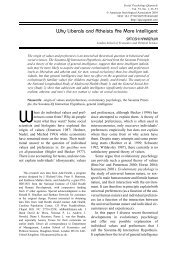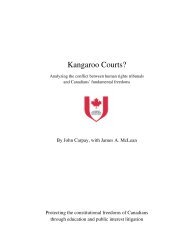- Page 2:
CARLO MATTOGNO · THE REAL CASE FOR
- Page 8:
HOLOCAUST Handbooks Series, vol. 22
- Page 12:
6 CARLO MATTOGNO · THE REAL CASE F
- Page 16:
8 CARLO MATTOGNO · THE REAL CASE F
- Page 20:
10 CARLO MATTOGNO · THE REAL CASE
- Page 24:
12 CARLO MATTOGNO · THE REAL CASE
- Page 28:
14 CARLO MATTOGNO · THE REAL CASE
- Page 32:
16 CARLO MATTOGNO · THE REAL CASE
- Page 36:
18 CARLO MATTOGNO · THE REAL CASE
- Page 40:
20 CARLO MATTOGNO · THE REAL CASE
- Page 44:
22 CARLO MATTOGNO · THE REAL CASE
- Page 48:
24 CARLO MATTOGNO · THE REAL CASE
- Page 52:
26 CARLO MATTOGNO · THE REAL CASE
- Page 56:
28 CARLO MATTOGNO · THE REAL CASE
- Page 60:
30 CARLO MATTOGNO · THE REAL CASE
- Page 64:
32 CARLO MATTOGNO · THE REAL CASE
- Page 68:
34 CARLO MATTOGNO · THE REAL CASE
- Page 72:
36 CARLO MATTOGNO · THE REAL CASE
- Page 76:
38 CARLO MATTOGNO · THE REAL CASE
- Page 80:
40 CARLO MATTOGNO · THE REAL CASE
- Page 84:
42 CARLO MATTOGNO · THE REAL CASE
- Page 88:
44 CARLO MATTOGNO · THE REAL CASE
- Page 92:
46 CARLO MATTOGNO · THE REAL CASE
- Page 96:
48 CARLO MATTOGNO · THE REAL CASE
- Page 100:
50 CARLO MATTOGNO · THE REAL CASE
- Page 104:
52 CARLO MATTOGNO · THE REAL CASE
- Page 108:
54 CARLO MATTOGNO · THE REAL CASE
- Page 112:
56 CARLO MATTOGNO · THE REAL CASE
- Page 116:
58 CARLO MATTOGNO · THE REAL CASE
- Page 120:
60 CARLO MATTOGNO · THE REAL CASE
- Page 124:
62 CARLO MATTOGNO · THE REAL CASE
- Page 128:
64 CARLO MATTOGNO · THE REAL CASE
- Page 132:
66 CARLO MATTOGNO · THE REAL CASE
- Page 136:
68 CARLO MATTOGNO · THE REAL CASE
- Page 140:
70 CARLO MATTOGNO · THE REAL CASE
- Page 144:
72 CARLO MATTOGNO · THE REAL CASE
- Page 148:
74 CARLO MATTOGNO · THE REAL CASE
- Page 152:
76 CARLO MATTOGNO · THE REAL CASE
- Page 156:
78 CARLO MATTOGNO · THE REAL CASE
- Page 160:
80 CARLO MATTOGNO · THE REAL CASE
- Page 164:
82 CARLO MATTOGNO · THE REAL CASE
- Page 168:
84 CARLO MATTOGNO · THE REAL CASE
- Page 172:
86 CARLO MATTOGNO · THE REAL CASE
- Page 176:
88 CARLO MATTOGNO · THE REAL CASE
- Page 180:
90 CARLO MATTOGNO · THE REAL CASE
- Page 184:
92 CARLO MATTOGNO · THE REAL CASE
- Page 188:
94 CARLO MATTOGNO · THE REAL CASE
- Page 192:
96 CARLO MATTOGNO · THE REAL CASE
- Page 196:
98 CARLO MATTOGNO · THE REAL CASE
- Page 200:
100 CARLO MATTOGNO · THE REAL CASE
- Page 204:
102 CARLO MATTOGNO · THE REAL CASE
- Page 208:
104 CARLO MATTOGNO · THE REAL CASE
- Page 212:
106 CARLO MATTOGNO · THE REAL CASE
- Page 216:
108 CARLO MATTOGNO · THE REAL CASE
- Page 220:
110 CARLO MATTOGNO · THE REAL CASE
- Page 224:
112 CARLO MATTOGNO · THE REAL CASE
- Page 228:
114 CARLO MATTOGNO · THE REAL CASE
- Page 232:
116 CARLO MATTOGNO · THE REAL CASE
- Page 236:
118 CARLO MATTOGNO · THE REAL CASE
- Page 240:
120 CARLO MATTOGNO · THE REAL CASE
- Page 244:
122 CARLO MATTOGNO · THE REAL CASE
- Page 248:
124 CARLO MATTOGNO · THE REAL CASE
- Page 252:
126 CARLO MATTOGNO · THE REAL CASE
- Page 256:
128 CARLO MATTOGNO · THE REAL CASE
- Page 260:
130 CARLO MATTOGNO · THE REAL CASE
- Page 264:
132 CARLO MATTOGNO · THE REAL CASE
- Page 268:
134 CARLO MATTOGNO · THE REAL CASE
- Page 272:
136 CARLO MATTOGNO · THE REAL CASE
- Page 276:
138 CARLO MATTOGNO · THE REAL CASE
- Page 280:
140 CARLO MATTOGNO · THE REAL CASE
- Page 284:
142 CARLO MATTOGNO · THE REAL CASE
- Page 288:
144 CARLO MATTOGNO · THE REAL CASE
- Page 292:
146 CARLO MATTOGNO · THE REAL CASE
- Page 296:
148 CARLO MATTOGNO · THE REAL CASE
- Page 300:
150 CARLO MATTOGNO · THE REAL CASE
- Page 304:
152 CARLO MATTOGNO · THE REAL CASE
- Page 308:
154 CARLO MATTOGNO · THE REAL CASE
- Page 312:
156 CARLO MATTOGNO · THE REAL CASE
- Page 316:
158 CARLO MATTOGNO · THE REAL CASE
- Page 320:
160 CARLO MATTOGNO · THE REAL CASE
- Page 324:
162 CARLO MATTOGNO · THE REAL CASE
- Page 328:
164 CARLO MATTOGNO · THE REAL CASE
- Page 332:
166 CARLO MATTOGNO · THE REAL CASE
- Page 336:
168 CARLO MATTOGNO · THE REAL CASE
- Page 340:
170 CARLO MATTOGNO · THE REAL CASE
- Page 344:
172 CARLO MATTOGNO · THE REAL CASE
- Page 348:
174 CARLO MATTOGNO · THE REAL CASE
- Page 352:
176 CARLO MATTOGNO · THE REAL CASE
- Page 356:
178 CARLO MATTOGNO · THE REAL CASE
- Page 360:
180 CARLO MATTOGNO · THE REAL CASE
- Page 364:
182 CARLO MATTOGNO · THE REAL CASE
- Page 368:
184 CARLO MATTOGNO · THE REAL CASE
- Page 372:
186 CARLO MATTOGNO · THE REAL CASE
- Page 376:
188 CARLO MATTOGNO · THE REAL CASE
- Page 380:
190 CARLO MATTOGNO · THE REAL CASE
- Page 384:
192 CARLO MATTOGNO · THE REAL CASE
- Page 388:
194 CARLO MATTOGNO · THE REAL CASE
- Page 392:
196 CARLO MATTOGNO · THE REAL CASE
- Page 396:
198 CARLO MATTOGNO · THE REAL CASE
- Page 400:
200 CARLO MATTOGNO · THE REAL CASE
- Page 404:
202 CARLO MATTOGNO · THE REAL CASE
- Page 408:
204 CARLO MATTOGNO · THE REAL CASE
- Page 412:
206 CARLO MATTOGNO · THE REAL CASE
- Page 416:
208 CARLO MATTOGNO · THE REAL CASE
- Page 420:
210 CARLO MATTOGNO · THE REAL CASE
- Page 424:
212 CARLO MATTOGNO · THE REAL CASE
- Page 428:
214 CARLO MATTOGNO · THE REAL CASE
- Page 432:
216 CARLO MATTOGNO · THE REAL CASE
- Page 436:
218 CARLO MATTOGNO · THE REAL CASE
- Page 440:
220 CARLO MATTOGNO · THE REAL CASE
- Page 444:
222 CARLO MATTOGNO · THE REAL CASE
- Page 448:
224 CARLO MATTOGNO · THE REAL CASE
- Page 452:
226 CARLO MATTOGNO · THE REAL CASE
- Page 456:
228 CARLO MATTOGNO · THE REAL CASE
- Page 460:
230 CARLO MATTOGNO · THE REAL CASE
- Page 464:
232 CARLO MATTOGNO · THE REAL CASE
- Page 468:
234 CARLO MATTOGNO · THE REAL CASE
- Page 472:
236 CARLO MATTOGNO · THE REAL CASE
- Page 476:
238 CARLO MATTOGNO · THE REAL CASE
- Page 480:
240 CARLO MATTOGNO · THE REAL CASE
- Page 484:
242 CARLO MATTOGNO · THE REAL CASE
- Page 488:
244 CARLO MATTOGNO · THE REAL CASE
- Page 492:
246 CARLO MATTOGNO · THE REAL CASE
- Page 496:
248 CARLO MATTOGNO · THE REAL CASE
- Page 500:
250 CARLO MATTOGNO · THE REAL CASE
- Page 504:
252 CARLO MATTOGNO · THE REAL CASE
- Page 508:
254 CARLO MATTOGNO · THE REAL CASE
- Page 512:
256 CARLO MATTOGNO · THE REAL CASE
- Page 516:
258 CARLO MATTOGNO · THE REAL CASE
- Page 520:
260 CARLO MATTOGNO · THE REAL CASE
- Page 524:
262 CARLO MATTOGNO · THE REAL CASE
- Page 528:
264 CARLO MATTOGNO · THE REAL CASE
- Page 532:
266 CARLO MATTOGNO · THE REAL CASE
- Page 536:
268 CARLO MATTOGNO · THE REAL CASE
- Page 540:
270 CARLO MATTOGNO · THE REAL CASE
- Page 544:
272 CARLO MATTOGNO · THE REAL CASE
- Page 548:
274 CARLO MATTOGNO · THE REAL CASE
- Page 552:
276 CARLO MATTOGNO · THE REAL CASE
- Page 556:
278 CARLO MATTOGNO · THE REAL CASE
- Page 560:
280 CARLO MATTOGNO · THE REAL CASE
- Page 564:
282 CARLO MATTOGNO · THE REAL CASE
- Page 568:
284 CARLO MATTOGNO · THE REAL CASE
- Page 572:
286 CARLO MATTOGNO · THE REAL CASE
- Page 576:
288 CARLO MATTOGNO · THE REAL CASE
- Page 580:
290 CARLO MATTOGNO · THE REAL CASE
- Page 584:
292 CARLO MATTOGNO · THE REAL CASE
- Page 588:
294 CARLO MATTOGNO · THE REAL CASE
- Page 592:
296 CARLO MATTOGNO · THE REAL CASE
- Page 596:
298 CARLO MATTOGNO · THE REAL CASE
- Page 600:
300 CARLO MATTOGNO · THE REAL CASE
- Page 604:
302 CARLO MATTOGNO · THE REAL CASE
- Page 608:
304 CARLO MATTOGNO · THE REAL CASE
- Page 612:
306 CARLO MATTOGNO · THE REAL CASE
- Page 616:
308 CARLO MATTOGNO · THE REAL CASE
- Page 620:
310 CARLO MATTOGNO · THE REAL CASE
- Page 624:
312 CARLO MATTOGNO · THE REAL CASE
- Page 628:
314 CARLO MATTOGNO · THE REAL CASE
- Page 632:
316 CARLO MATTOGNO · THE REAL CASE
- Page 636:
318 CARLO MATTOGNO · THE REAL CASE
- Page 640:
320 CARLO MATTOGNO · THE REAL CASE
- Page 644:
322 CARLO MATTOGNO · THE REAL CASE
- Page 648:
324 CARLO MATTOGNO · THE REAL CASE
- Page 652:
326 CARLO MATTOGNO · THE REAL CASE
- Page 656:
328 CARLO MATTOGNO · THE REAL CASE
- Page 660:
330 CARLO MATTOGNO · THE REAL CASE
- Page 664:
332 CARLO MATTOGNO · THE REAL CASE
- Page 668:
334 CARLO MATTOGNO · THE REAL CASE
- Page 672:
336 CARLO MATTOGNO · THE REAL CASE
- Page 676:
338 CARLO MATTOGNO · THE REAL CASE
- Page 680:
340 CARLO MATTOGNO · THE REAL CASE
- Page 684:
342 CARLO MATTOGNO · THE REAL CASE
- Page 688:
344 CARLO MATTOGNO · THE REAL CASE
- Page 692:
346 CARLO MATTOGNO · THE REAL CASE
- Page 696:
348 CARLO MATTOGNO · THE REAL CASE
- Page 700:
350 CARLO MATTOGNO · THE REAL CASE
- Page 704:
352 CARLO MATTOGNO · THE REAL CASE
- Page 708:
354 CARLO MATTOGNO · THE REAL CASE
- Page 712:
356 CARLO MATTOGNO · THE REAL CASE
- Page 716:
358 CARLO MATTOGNO · THE REAL CASE
- Page 720:
360 CARLO MATTOGNO · THE REAL CASE
- Page 724:
362 CARLO MATTOGNO · THE REAL CASE
- Page 728:
364 CARLO MATTOGNO · THE REAL CASE
- Page 732:
366 CARLO MATTOGNO · THE REAL CASE
- Page 736:
368 CARLO MATTOGNO · THE REAL CASE
- Page 740:
370 CARLO MATTOGNO · THE REAL CASE
- Page 744:
372 CARLO MATTOGNO · THE REAL CASE
- Page 748:
374 CARLO MATTOGNO · THE REAL CASE
- Page 752:
376 CARLO MATTOGNO · THE REAL CASE
- Page 756:
378 CARLO MATTOGNO · THE REAL CASE
- Page 760:
380 CARLO MATTOGNO · THE REAL CASE
- Page 764:
382 CARLO MATTOGNO · THE REAL CASE
- Page 768:
384 CARLO MATTOGNO · THE REAL CASE
- Page 772:
386 CARLO MATTOGNO · THE REAL CASE
- Page 776:
388 CARLO MATTOGNO · THE REAL CASE
- Page 780:
390 CARLO MATTOGNO · THE REAL CASE
- Page 784:
392 CARLO MATTOGNO · THE REAL CASE
- Page 788:
394 CARLO MATTOGNO · THE REAL CASE
- Page 792:
396 CARLO MATTOGNO · THE REAL CASE
- Page 796:
398 CARLO MATTOGNO · THE REAL CASE
- Page 800:
400 CARLO MATTOGNO · THE REAL CASE
- Page 804:
402 CARLO MATTOGNO · THE REAL CASE
- Page 808:
404 CARLO MATTOGNO · THE REAL CASE
- Page 812:
406 CARLO MATTOGNO · THE REAL CASE
- Page 816:
408 CARLO MATTOGNO · THE REAL CASE
- Page 820:
410 CARLO MATTOGNO · THE REAL CASE
- Page 824:
412 CARLO MATTOGNO · THE REAL CASE
- Page 828: 414 CARLO MATTOGNO · THE REAL CASE
- Page 832: 416 CARLO MATTOGNO · THE REAL CASE
- Page 836: 418 CARLO MATTOGNO · THE REAL CASE
- Page 840: 420 CARLO MATTOGNO · THE REAL CASE
- Page 844: 422 CARLO MATTOGNO · THE REAL CASE
- Page 848: 424 CARLO MATTOGNO · THE REAL CASE
- Page 852: 426 CARLO MATTOGNO · THE REAL CASE
- Page 856: 428 CARLO MATTOGNO · THE REAL CASE
- Page 860: 430 CARLO MATTOGNO · THE REAL CASE
- Page 866: CARLO MATTOGNO · THE REAL CASE FOR
- Page 870: CARLO MATTOGNO · THE REAL CASE FOR
- Page 874: CARLO MATTOGNO · THE REAL CASE FOR
- Page 880: 440 CARLO MATTOGNO · THE REAL CASE
- Page 884: 442 CARLO MATTOGNO · THE REAL CASE
- Page 888: 444 CARLO MATTOGNO · THE REAL CASE
- Page 892: 446 CARLO MATTOGNO · THE REAL CASE
- Page 896: 448 CARLO MATTOGNO · THE REAL CASE
- Page 900: 450 CARLO MATTOGNO · THE REAL CASE
- Page 904: 452 CARLO MATTOGNO · THE REAL CASE
- Page 908: 454 CARLO MATTOGNO · THE REAL CASE
- Page 912: 456 CARLO MATTOGNO · THE REAL CASE
- Page 916: 458 CARLO MATTOGNO · THE REAL CASE
- Page 920: 460 CARLO MATTOGNO · THE REAL CASE
- Page 924: 462 CARLO MATTOGNO · THE REAL CASE
- Page 928:
464 CARLO MATTOGNO · THE REAL CASE
- Page 932:
466 CARLO MATTOGNO · THE REAL CASE
- Page 936:
468 CARLO MATTOGNO · THE REAL CASE
- Page 940:
470 CARLO MATTOGNO · THE REAL CASE
- Page 944:
472 CARLO MATTOGNO · THE REAL CASE
- Page 948:
474 CARLO MATTOGNO · THE REAL CASE
- Page 952:
476 CARLO MATTOGNO · THE REAL CASE
- Page 956:
478 CARLO MATTOGNO · THE REAL CASE
- Page 960:
480 CARLO MATTOGNO · THE REAL CASE
- Page 964:
482 CARLO MATTOGNO · THE REAL CASE
- Page 968:
484 CARLO MATTOGNO · THE REAL CASE
- Page 972:
486 CARLO MATTOGNO · THE REAL CASE
- Page 976:
488 CARLO MATTOGNO · THE REAL CASE
- Page 980:
490 CARLO MATTOGNO · THE REAL CASE
- Page 984:
492 CARLO MATTOGNO · THE REAL CASE
- Page 988:
494 CARLO MATTOGNO · THE REAL CASE
- Page 992:
496 CARLO MATTOGNO · THE REAL CASE
- Page 996:
498 CARLO MATTOGNO · THE REAL CASE
- Page 1000:
500 CARLO MATTOGNO · THE REAL CASE
- Page 1004:
502 CARLO MATTOGNO · THE REAL CASE
- Page 1008:
504 CARLO MATTOGNO · THE REAL CASE
- Page 1012:
506 CARLO MATTOGNO · THE REAL CASE
- Page 1016:
508 CARLO MATTOGNO · THE REAL CASE
- Page 1020:
510 CARLO MATTOGNO · THE REAL CASE
- Page 1024:
512 CARLO MATTOGNO · THE REAL CASE
- Page 1028:
514 CARLO MATTOGNO · THE REAL CASE
- Page 1032:
516 CARLO MATTOGNO · THE REAL CASE
- Page 1036:
518 CARLO MATTOGNO · THE REAL CASE
- Page 1040:
520 CARLO MATTOGNO · THE REAL CASE
- Page 1044:
522 CARLO MATTOGNO · THE REAL CASE
- Page 1048:
524 CARLO MATTOGNO · THE REAL CASE
- Page 1052:
526 CARLO MATTOGNO · THE REAL CASE
- Page 1056:
528 CARLO MATTOGNO · THE REAL CASE
- Page 1060:
530 CARLO MATTOGNO · THE REAL CASE
- Page 1064:
532 CARLO MATTOGNO · THE REAL CASE
- Page 1068:
534 CARLO MATTOGNO · THE REAL CASE
- Page 1072:
536 CARLO MATTOGNO · THE REAL CASE
- Page 1076:
538 CARLO MATTOGNO · THE REAL CASE
- Page 1080:
540 CARLO MATTOGNO · THE REAL CASE
- Page 1084:
542 CARLO MATTOGNO · THE REAL CASE
- Page 1088:
544 CARLO MATTOGNO · THE REAL CASE
- Page 1092:
546 CARLO MATTOGNO · THE REAL CASE
- Page 1096:
548 CARLO MATTOGNO · THE REAL CASE
- Page 1100:
550 CARLO MATTOGNO · THE REAL CASE
- Page 1104:
552 CARLO MATTOGNO · THE REAL CASE
- Page 1108:
554 CARLO MATTOGNO · THE REAL CASE
- Page 1112:
556 CARLO MATTOGNO · THE REAL CASE
- Page 1116:
558 CARLO MATTOGNO · THE REAL CASE
- Page 1120:
560 CARLO MATTOGNO · THE REAL CASE
- Page 1124:
562 CARLO MATTOGNO · THE REAL CASE
- Page 1128:
564 CARLO MATTOGNO · THE REAL CASE
- Page 1132:
566 CARLO MATTOGNO · THE REAL CASE
- Page 1136:
568 CARLO MATTOGNO · THE REAL CASE
- Page 1140:
570 CARLO MATTOGNO · THE REAL CASE
- Page 1144:
572 CARLO MATTOGNO · THE REAL CASE
- Page 1148:
574 CARLO MATTOGNO · THE REAL CASE
- Page 1152:
576 CARLO MATTOGNO · THE REAL CASE
- Page 1156:
578 CARLO MATTOGNO · THE REAL CASE
- Page 1160:
580 CARLO MATTOGNO · THE REAL CASE
- Page 1164:
582 CARLO MATTOGNO · THE REAL CASE
- Page 1168:
584 CARLO MATTOGNO · THE REAL CASE
- Page 1172:
586 CARLO MATTOGNO · THE REAL CASE
- Page 1176:
588 CARLO MATTOGNO · THE REAL CASE
- Page 1180:
590 CARLO MATTOGNO · THE REAL CASE
- Page 1184:
592 CARLO MATTOGNO · THE REAL CASE
- Page 1188:
594 CARLO MATTOGNO · THE REAL CASE
- Page 1192:
596 CARLO MATTOGNO · THE REAL CASE
- Page 1196:
598 CARLO MATTOGNO · THE REAL CASE
- Page 1200:
600 CARLO MATTOGNO · THE REAL CASE
- Page 1204:
602 CARLO MATTOGNO · THE REAL CASE
- Page 1208:
604 CARLO MATTOGNO · THE REAL CASE
- Page 1212:
606 CARLO MATTOGNO · THE REAL CASE
- Page 1216:
608 CARLO MATTOGNO · THE REAL CASE
- Page 1220:
610 CARLO MATTOGNO · THE REAL CASE
- Page 1224:
612 CARLO MATTOGNO · THE REAL CASE
- Page 1228:
614 CARLO MATTOGNO · THE REAL CASE
- Page 1232:
616 CARLO MATTOGNO · THE REAL CASE
- Page 1236:
618 CARLO MATTOGNO · THE REAL CASE
- Page 1240:
620 CARLO MATTOGNO · THE REAL CASE
- Page 1244:
622 CARLO MATTOGNO · THE REAL CASE
- Page 1248:
624 CARLO MATTOGNO · THE REAL CASE
- Page 1252:
626 CARLO MATTOGNO · THE REAL CASE
- Page 1256:
628 CARLO MATTOGNO · THE REAL CASE
- Page 1260:
630 CARLO MATTOGNO · THE REAL CASE
- Page 1264:
632 CARLO MATTOGNO · THE REAL CASE
- Page 1268:
634 CARLO MATTOGNO · THE REAL CASE
- Page 1272:
636 CARLO MATTOGNO · THE REAL CASE
- Page 1276:
638 CARLO MATTOGNO · THE REAL CASE
- Page 1280:
640 CARLO MATTOGNO · THE REAL CASE
- Page 1284:
642 CARLO MATTOGNO · THE REAL CASE
- Page 1288:
644 CARLO MATTOGNO · THE REAL CASE
- Page 1292:
646 CARLO MATTOGNO · THE REAL CASE
- Page 1296:
648 CARLO MATTOGNO · THE REAL CASE
- Page 1300:
650 CARLO MATTOGNO · THE REAL CASE
- Page 1304:
652 CARLO MATTOGNO · THE REAL CASE
- Page 1308:
654 CARLO MATTOGNO · THE REAL CASE
- Page 1312:
656 CARLO MATTOGNO · THE REAL CASE
- Page 1316:
658 CARLO MATTOGNO · THE REAL CASE
- Page 1320:
660 CARLO MATTOGNO · THE REAL CASE
- Page 1326:
CARLO MATTOGNO · THE REAL CASE FOR
- Page 1330:
CARLO MATTOGNO · THE REAL CASE FOR
- Page 1334:
CARLO MATTOGNO · THE REAL CASE FOR
- Page 1338:
CARLO MATTOGNO · THE REAL CASE FOR
- Page 1342:
CARLO MATTOGNO · THE REAL CASE FOR
- Page 1346:
CARLO MATTOGNO · THE REAL CASE FOR
- Page 1350:
CARLO MATTOGNO · THE REAL CASE FOR
- Page 1354:
CARLO MATTOGNO · THE REAL CASE FOR
- Page 1358:
CARLO MATTOGNO · THE REAL CASE FOR
- Page 1362:
CARLO MATTOGNO · THE REAL CASE FOR
- Page 1366:
CARLO MATTOGNO · THE REAL CASE FOR
- Page 1370:
CARLO MATTOGNO · THE REAL CASE FOR
- Page 1374:
CARLO MATTOGNO · THE REAL CASE FOR
- Page 1378:
CARLO MATTOGNO · THE REAL CASE FOR
- Page 1382:
CARLO MATTOGNO · THE REAL CASE FOR
- Page 1386:
CARLO MATTOGNO · THE REAL CASE FOR
- Page 1390:
CARLO MATTOGNO · THE REAL CASE FOR
- Page 1394:
CARLO MATTOGNO · THE REAL CASE FOR
- Page 1398:
CARLO MATTOGNO · THE REAL CASE FOR
- Page 1402:
CARLO MATTOGNO · THE REAL CASE FOR
- Page 1406:
CARLO MATTOGNO · THE REAL CASE FOR
- Page 1410:
CARLO MATTOGNO · THE REAL CASE FOR
- Page 1414:
CARLO MATTOGNO · THE REAL CASE FOR
- Page 1418:
CARLO MATTOGNO · THE REAL CASE FOR
- Page 1422:
CARLO MATTOGNO · THE REAL CASE FOR
- Page 1426:
CARLO MATTOGNO · THE REAL CASE FOR
- Page 1430:
CARLO MATTOGNO · THE REAL CASE FOR
- Page 1434:
CARLO MATTOGNO · THE REAL CASE FOR
- Page 1438:
CARLO MATTOGNO · THE REAL CASE FOR
- Page 1442:
CARLO MATTOGNO · THE REAL CASE FOR
- Page 1446:
CARLO MATTOGNO · THE REAL CASE FOR
- Page 1450:
CARLO MATTOGNO · THE REAL CASE FOR
- Page 1454:
CARLO MATTOGNO · THE REAL CASE FOR
- Page 1458:
CARLO MATTOGNO · THE REAL CASE FOR
- Page 1462:
CARLO MATTOGNO · THE REAL CASE FOR
- Page 1466:
CARLO MATTOGNO · THE REAL CASE FOR
- Page 1470:
CARLO MATTOGNO · THE REAL CASE FOR
- Page 1474:
CARLO MATTOGNO · THE REAL CASE FOR
- Page 1478:
CARLO MATTOGNO · THE REAL CASE FOR
- Page 1482:
CARLO MATTOGNO · THE REAL CASE FOR
- Page 1486:
CARLO MATTOGNO · THE REAL CASE FOR
- Page 1490:
CARLO MATTOGNO · THE REAL CASE FOR
- Page 1494:
CARLO MATTOGNO · THE REAL CASE FOR
- Page 1498:
CARLO MATTOGNO · THE REAL CASE FOR
- Page 1502:
HOLOCAUST HANDBOOKS This ambitious,
- Page 1506:
HOLOCAUST HANDBOOKS www.HolocaustH
- Page 1510:
HOLOCAUST HANDBOOKS www.HolocaustH
- Page 1514:
BOOKS BY AND FROM CASTLE HILL PUBLI






